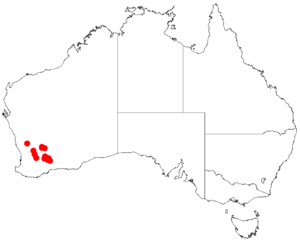Acacia cracentis facts for kids
Quick facts for kids Acacia cracentis |
|
|---|---|
| Scientific classification | |
| Genus: |
Acacia
|
| Species: |
cracentis
|
 |
|
| Occurrence data from AVH | |
Acacia cracentis is a type of shrub that belongs to the Acacia family. It is found only in the southwestern part of Australia. This means it is "endemic" to that area, growing naturally nowhere else in the world.
What it Looks Like
This bushy shrub usually grows to be about 0.5 to 2 meters (1.6 to 6.6 feet) tall. It often has a rounded or cone-like shape. Its small branches have tiny, silky hairs, especially near the ends. They also have sticky, raised lines, like ribs.
Like many Acacia plants, it doesn't have true leaves. Instead, it has special flattened stems called phyllodes that look and act like leaves. These slender, green phyllodes stick out or grow upwards. They are straight or slightly curved, measuring 2.5 to 6 centimeters (1 to 2.4 inches) long and 0.5 to 0.7 millimeters (0.02 to 0.03 inches) wide. Each phyllode has eight wide, flat-topped veins that are only slightly raised.
Acacia cracentis blooms from July to September, producing bright yellow flowers. Its simple flower clusters are usually found alone. Each flower-head is round or nearly round, about 4.5 to 6 millimeters (0.18 to 0.24 inches) across. It contains 12 to 20 golden-colored flowers.
After flowering, seed pods form. These pods stand upright and are long and thin. They are slightly raised over each seed and a bit narrower between them. The pods are thin and leathery, straight or slightly curved. They can grow up to 5 centimeters (2 inches) long and 1 to 2 millimeters (0.04 to 0.08 inches) wide. Inside, the glossy, spotted seeds are arranged lengthwise. The seeds are oval-shaped, about 2 to 2.5 millimeters (0.08 to 0.1 inches) long, and have a blunt, white tip called an aril.
Where it Grows
Acacia cracentis is native to a small part of the Wheatbelt region in Western Australia. It is spread out in different spots, from the Chiddarcooping Nature Reserve in the north down to the town of Hyden in the south. This covers a distance of about 200 kilometers (124 miles).
You can often find this plant growing among and around granite rock formations. It prefers gravelly loam soils. It is usually part of Melaleuca shrubland or low heath communities. It also grows near Eucalyptus stowardii and different types of Casuarina plants.

